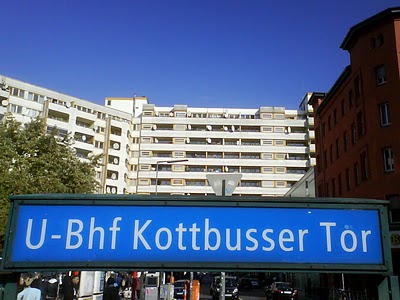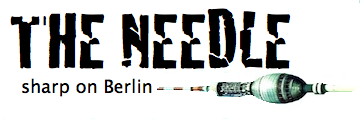 Kottbusser Tor, the centre of the ertswhile-radical SO36 district in Kreuzberg, is affectionately known as just ‘Kotti’. The surrounding kiez of immigrant housing, punk bars, gay clubs and halal eateries is diminutive, but packs a punch of contrasts. And it has something to say about multiculturalism and tolerance in Germany.
Kottbusser Tor, the centre of the ertswhile-radical SO36 district in Kreuzberg, is affectionately known as just ‘Kotti’. The surrounding kiez of immigrant housing, punk bars, gay clubs and halal eateries is diminutive, but packs a punch of contrasts. And it has something to say about multiculturalism and tolerance in Germany.
The complex of apartments on the north side of the square, the Neue Kreuzberger Zentrum (NKZ), built in the 1970s, is populated in the majority by families originating from poorer regions of Turkey. Its facade is covered with satellite dishes, attesting to the cultural and linguistic ties to the home country. It’s also a sign of exclusion from German life.
The buildings are falling apart, they are water stained and cold in winter, and just as guest workers arriving in the sixties and seventies were expected to return home (they didn’t), these buildings weren’t built to last.
These past weeks there has been a vigourous discussion in the German press about whether multiculturalism in Germany has, as Chancellor Merkel put it, ‘utterly failed‘. She did not mean immigrants were unwanted, but rather that they had not been sufficiently integrated.
It is true that children who live in these Siedlungen, immigrant housing blocks, speak heavily accented German, and go to schools which are almost exlusively Turkish and/or Lebanese. They remain, for the most part, in traditional households whose mores resemble rural Anatolia, with the women veiled and at home, more than what we might expect from urbanite Northern Europe.
And yet the discussion in the press puts too much emphasis on the immigrants’ religious separateness and failure to integrate instead of on unreconstructed notions of race and nation in Germany that are regrettably still very much the majority view.
Immigrants of Turkish origin are not called ‘Germans’, they are ‘Turkish’ or of ‘Turkish descent’. 88 000 people live in Germany without residence permits and some born here fear deportation to a ‘country of origin’ where they have never been. Immigrant accents have very low social capital and the idea of bilingual schools is resisted. And there is not enough discussion about the continuities of racially-defined citizenship in 20th-century German history, and the debt to pluralism. Today, immigrants are being asked to integrate, but will they be allowed to?
I think Kotti is the part of Berlin that feels most like New York. It’s not just the twenty-four hour florists, the six-floor buildings that remind me of tenements on the Lower East Side, or the hipsters playing as rebels. It’s also the way in which very diverse communities actually co-exist here with relative success.
Back in the Neue Kreuzberger Zentrum, I am walking through a series of occassional buildings, supermarkets, casinos and kebab shops that fill the alleys. There are small businesses owned by Bosnians, ‘Germans’, Turks and Kurds. There is a gay-friendly café up one level, next to a betting office, and then below a funky gay bar called Möbel Olfe (named after a furniture store).
I am amazed that there are no broken windows in the gay bar. I don’t for a moment believe that homosexuality is accepted in traditional immigrant circles, but there is at least peaceful coexistence. In this way too, Kotti has the feeling of the cosmopolitan centres of the world–– London, Toronto, Queens––where difference is not a problem but simply a fact.
But here one feels enclosed by these crumbling concrete towers, the alleys are claustrophobic,there is the feeling of New York, but then the knowledge that immigrants here don’t have the promise made to so many of their New World counterparts. A place like this should be where you start out on your immigrant dream, before you get your big break, or your kids become professionals ––no matter where you’re from, no matter what accent you use to speak German.
But here, you’re from that place that flickers on the screen. When you leave the house, you know where your world ends. You’re from Kotti.
View Larger Map
 Kottbusser Tor, the centre of the ertswhile-radical SO36 district in Kreuzberg, is affectionately known as just ‘Kotti’. The surrounding kiez of immigrant housing, punk bars, gay clubs and halal eateries is diminutive, but packs a punch of contrasts. And it has something to say about multiculturalism and tolerance in Germany.
Kottbusser Tor, the centre of the ertswhile-radical SO36 district in Kreuzberg, is affectionately known as just ‘Kotti’. The surrounding kiez of immigrant housing, punk bars, gay clubs and halal eateries is diminutive, but packs a punch of contrasts. And it has something to say about multiculturalism and tolerance in Germany.




Yeah, I agree with the Kreuzberg/LES Manhattan comparison, I came to NYC from Berlin (1984) and that was my immediate impression too, and indeed that the West Village came on a bit like Amsterdam…
I moved here from NY too, and keep making the comparisons, doing each city a disservice by trying to map my NY onto Berlin and vice versa…